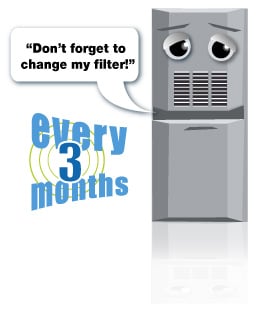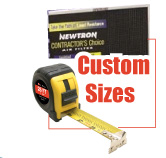
Understanding Furnace Filters
 As concern grows for the air quality outdoors, many are overlooking an increasingly toxic indoor environment. Homes and offices are much more tightly sealed than ever before, and for those sensitive to certain pets, VOC’s or other compounds found in new carpet, paint, and even furniture, indoor air quality can be as difficult to handle as the air outdoors. Since indoor air pollution cannot really escape a tightly sealed office or home, the next best way to keep the air circulating indoors clear of pollution is with a quality HVAC or furnace filter. This quick Furnace Filter Buying Guide points out some of the key features you should look for to address your filtration needs.
As concern grows for the air quality outdoors, many are overlooking an increasingly toxic indoor environment. Homes and offices are much more tightly sealed than ever before, and for those sensitive to certain pets, VOC’s or other compounds found in new carpet, paint, and even furniture, indoor air quality can be as difficult to handle as the air outdoors. Since indoor air pollution cannot really escape a tightly sealed office or home, the next best way to keep the air circulating indoors clear of pollution is with a quality HVAC or furnace filter. This quick Furnace Filter Buying Guide points out some of the key features you should look for to address your filtration needs.
In general, furnace filters clean dust, dirt and debris from the air stream that passes through an HVAC system. Keeping such particles out of the furnace improves indoor air quality while protecting and extending the life of the furnace motor and internal components. Allergen reduction filters, such as those we offer, include the added benefit of filtering allergen particles from the air. With the right furnace filter you can help to keep your HVAC running better, for longer, while making the air in your home healthier. While furnace filters can have a lot of upside, if not used properly, a furnace filter will actually hinder the passage of air or facilitate the introduction of dust and other allergens into your home environment. To avoid this, it’s important to remember to change your filter regularly if it’s a disposable kind. Or, contact a local hvac system services company and have a furnace repair technician clean it if it’s permanent style HVAC filter. When used as part of an overall strategy, furnace filters are an effective way to minimize the allergens in your home. Aside from the filters, you should also inspect the propane tank of your heating system as regularly as your filter changes.
Furnace Filter Buying Guide – Types of Furnace Filters
Electrostatic – Often, electrostatic filters are often semi-permanent or very long lasting, washable filters that carry an electronic charge. This charge attracts dust particles much like a magnet. The Newtron Contractor’s Choice Permanent Air Filter is a great example of a semi-permanent, washable filter. Both of the 3M Filtrete filters that we offer – the Ultra furnace filter and 4″ thick replacement filter – feature electrostatic filtration, in addition to mechanical (physical) means to attract and capture particles. In addition to 3M furnace filters, AllergyZone furnace filters are also electrostatically charged and great for removing allergens.
Pleated – The pleats in filter media of HVAC filters increase the surface area, and thereby the effectiveness, where particles can be captured. All of the AllergyZone and 3M filters we offer are pleated filters. The Filtrete 4″ furnace filters are also both pleated and electrostatic; Filtrete’s 4″ Media filter, however, because of its added depth, offers more surface area for capturing particles.
HEPA – Although HEPA filters are the gold standard when it comes to filters in air purifiers and vacuum cleaners, they often create too much air flow resistance when it comes to furnace filters. Using a HEPA rated or equivalent filter is something you should thoroughly research prior to investing in. Some offer HEPA or near HEPA filtration without cutting down air flow to the point of damaging your HVAC unit, but they may still reduce air flow throughout the house, slowing the cooling or heating process.
Activated Carbon – An activated carbon component in a furnace filter enables it to absorb chemicals, fumes, and odors as air passes through your HVAC system.SafeHome Duo Furnace Filters and the SafeHome System Air Return Filters both feature an activated carbon blend to filter out not only allergens, but hazardous chemicals as well, including formaldehyde, ozone, and VOCs.
Changing Furnace Filters
Each of our filters comes with recommendations regarding how often to change them or wash them. In general, disposable furnace filters should be changed once every three months. However, during the winter and summer months when your HVAC system is running often, you may need to change filters more frequently. Similarly, if there’s a condition that would make the filters become saturated faster than usual (such as open windows during pollen season, or several pets in the household), you will need to change your filters more frequently.
To learn more about changing your filter, see When’s the Last Time You Changed Your Furnace Filter?
Furnace Filter Sizing
There’s a wide range of furnace filter slot sizes, and most of the furnace filters we offer come in a wide variety of sizes. In addition,SafeHome System Air Return Filters, as well as the AllergyZone,and Newtron Contractor’s Choice are all available in custom sizes.

Furnace Filter Buying Guide – What is MERV?
The Minimum Efficiency Reporting Value, or MERV, is a universal standard used to compare one furnace filter’s efficiency to another’s. When a furnace filter states a MERV, it usually refers to the E3 portion of MERV, which reports a filter’s success in capturing larger particles between 3 and 10 microns. Although this is a useful rating to compare filters, it’s important to realize that for most allergy or asthma sufferers, most of the particulate you are interested in capturing is going to be much smaller than this. So while a furnace filter will not capture most submicron particles, they can effectively remove many of the particles that form dust in your home.
The trade-off between high MERV ratings and efficiency is that sometimes a high MERV can reduce the airflow of your HVAC system. Particularly true with the SafeHome Furnace Filters, this is the reason the manufacturer suggests a MERV 7 filter for use in conjunction with the SafeHome System Annual Packs (MERV 7 is what they come with). A MERV 8 filter is what comes standard with the SafeHome Duo. Since SafeHome filter sets are designed specifically to remove chemicals as well as allergens from the air and have that extra layer of carbon filter media, it’s necessary for airflow through the other filters to be as unimpeded as possible.
That said, when allergen reduction is the primary goal, a high MERV is generally desirable. Filtrete Furnace Filters have impressive MERV ratings: The Ultra Allergen Reduction filters all have a MERV rating of 11. This is generally better than average and represents a bit below HEPA filtration. The AllergyZone Furnace Filter has a MERV of 12, which is effectively the last rung before HEPA grade filtration.

What is MPR?
MPR is a term used by 3M and stands for Microparticle Performance Rating. It is actually the E1 part of the MERV rating, and measures how efficient an air filter is at capturing particles between 0.3 and 1 micron in size, which make up 99% of the air’s particulate matter. Smoke, bacteria, and smog particles all fall within this size range, so if filtering these out of the air is important to you, MPR is a good criteria to consider. MPR is used to compare furnace filters to one another, and cannot accurately predict how a furnace filter will actually perform in your particular home environment. However, comparing MPRs is a good way to see the differences in efficiency between Filtrete furnace filters. The higher the MPR, the more efficient the filter is at capturing these small particles. For instance, the Filtrete Micro filters have an MPR of 1000, the Filtrete Ultra filters have an MPR of 1250, while Filtrete Advanced filters stand at 1500, and Filtrete Ultimate filters come in at a whopping 1900. The Filtrete 4″ Media Filter has an MPR of 1550.
So when choosing a furnace filter, keep in mind your needs as well as price and what features each particular style has to offer. Not all furnace filters are created equally, and just because your HVAC may be tucked away in the basement doesn’t mean you shouldn’t do what you can to keep it running efficiently and your family breathing better! Your HVAC/furnace filter is your first line of defense against airborne allergens, so keep track of replacement intervals and every three months, swap out your disposable filter or rinse your semi-permanent filter.
